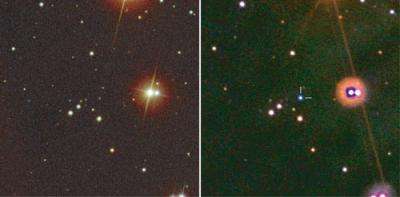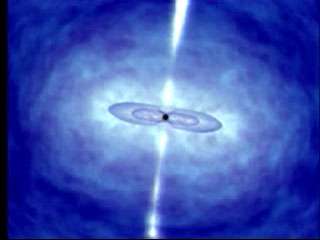New Kind of Cosmic Explosion Detected

Scientists using NASA's Swift satellite have detected a new kind of cosmic explosion. The event appears to be a precursor to a supernova, which is expected to reach peak brightness in about a week's time. UK astronomers and their colleagues around the world are watching closely as they have never seen an explosion of this kind before.
Satellites and the world's largest telescopes are now trained on the sight, watching and waiting. The explosion has the trappings of a gamma-ray burst (GRB), the most distant and powerful type of explosion known. Yet this explosion, detected on February 18 2006, was very much closer and 100 times longer than the typical gamma-ray burst. And it possesses characteristics never seen before.
Dr Julian Osborne, lead investigator for Swift at the University of Leicester said "The bright X-ray source seen when Swift slewed to the burst varied rather slowly for about 40 minutes, quite different to the very rapid decline of more normal GRBs. It did later decline much more rapidly, like a normal GRB, so the challenge will be to find a physical description of the explosion expanding into the host galaxy gas which matches this new pattern"

"This is totally new and unexpected," said Neil Gehrels, Swift principal investigator at NASA's Goddard Space Flight Center in Greenbelt, Md. "This is the type of unscripted event in our nearby universe that we hoped Swift could catch."
The explosion, called GRB 060218 after the date it was discovered, originated in a star-forming galaxy about 440 million light-years away toward the constellation Aries. This is the second-closest gamma-ray burst ever detected, if indeed it is a true burst.
The burst of gamma rays lasted for nearly 2,000 seconds; most bursts last a few milliseconds to tens of seconds. The explosion was surprisingly dim, however,given its relative closeness, suggesting that scientists might be viewing the event slightly off-axis. Yet this is just one explanation on the table. The standard theory for gamma-ray bursts is that the high-energy light is beamed in our direction.
Dr Nial Tanvir of the University of Hertfordshire is studying the event and said "This is a very odd GRB, but it also seems to be a very unusual supernova. Astronomers have observed many thousands of supernovae over the years, and never seen the strange gamma-ray display we've witnessed here."
Professor Keith Mason, Chief Executive of the Particle Physics and Astronomy Research Council which funds UK participation in Swift, led UK work on Swift's Ultraviolet and Optical Telescope (UVOT). He said "This is extremely exciting, not only for what it can potentially tell us about the relationship between gamma-ray bursts and `ordinary' supernova explosions, but also because the detection of the gamma-ray flash has alerted us to the potential presence of a nearby supernova, which we can now study in detail from the very beginning. Usually these events are not detected until after the exploding star has brightened substantially in the optical band, many days after the initial explosion."
A European team, including astronomers from the Universities of Leicester and Hertfordshire, led by Italy's National Institute for Astrophysics (INAF) has found hints of a budding supernova. Using the European Southern Observatory's Very Large Telescope in Chile, the scientists have watched the afterglow of this burst grow brighter in optical light. This brightening, along with other tell-tale spectral characteristics in the light, strongly suggests that a supernova is unfolding.
"We expected to see the typical featureless spectrum of a gamma-ray burst afterglow, but instead we found a mixture between this and the more complex spectrum of a supernova similar to those generally observed weeks after the gamma-ray burst," said Nicola Masetti of INAF's Institute for Space Astrophysics and Cosmic Physics (IASF) in Bologna. "A supernova must be in the works."
Masetti said this could be a Type Ic supernova, characterized by its massive size and the abundance of certain chemical elements. This implies a scenario in which a very massive star has collapsed into a black hole and subsequently exploded; the debris from the explosion is trapping optical light inside and as the dust settles, more and more light will break free.
If they are correct, scientists will have an unprecedented view of a supernova from start to finish across many wavelengths, from radio through X-ray. Radio telescopes in fact have seen this burst from the day it was detected, another first.
Because the burst was so long, Swift was able to observe the bulk of the explosion with all three of its instruments: the Burst Alert Telescope, which detected the burst; and the X-ray Telescope and Ultraviolet/Optical Telescope, which provide high-resolution imagery and spectra across a broad range of wavelengths.
Scientists are making observations with the Hubble Space Telescope, and the Chandra X-ray and XMM-Newton Observatories as well as ground based telescopes such as ESO's Very Large Telescope and the UK's robotic Liverpool Telescope on Tenerife and UKIRT on Hawaii. Amateur astronomers in dark skies in the northern hemisphere might be able to see the explosion with a 16-inch telescope as it hits 16th magnitude brightness for a few hours after sunset.
Source: PPARC


















